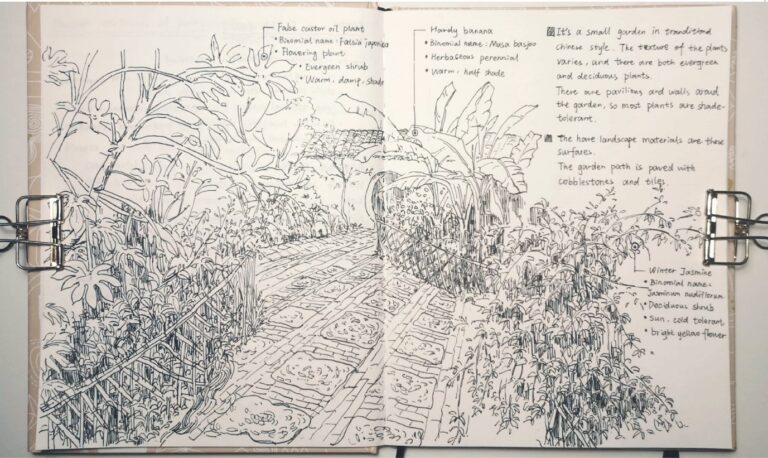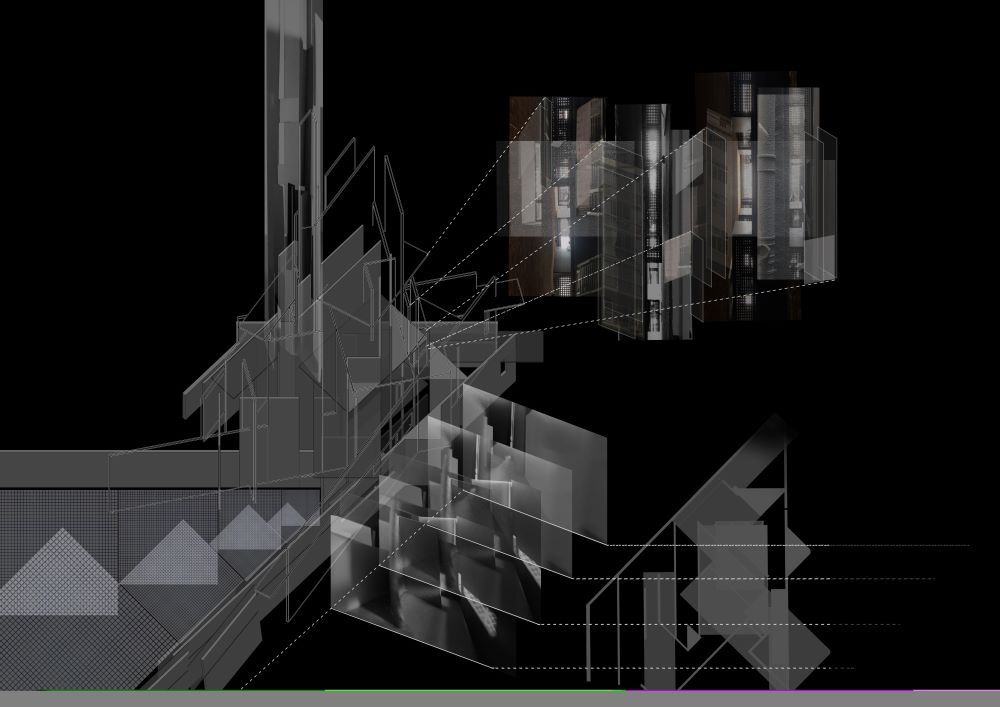
In this second part to the post from December 1st, 2020, the authors illustrate how the shift to hybrid learning has enabled them to rethink and revalue the pedagogical approach to “reading” sites from a distance in their Architecture course design…
“Reading” sites from a distance
The increasingly globalised condition of twenty-first century landscape/ architectural design practice has been argued to intensify spatial and ecological design disciplines’ interfaces as ‘remote practices’, primarily manifesting ideas, modes of production and critiques ‘in absentia’ [ https://remote-practices.com conference organised by National University of Singapore/ University of Sydney, October 2020]. With practices of landscape/architecture now adjusting and re-tuning to the condition of pandemic distancing, the value and means of visiting sites – in person and virtually – are necessarily becoming more deliberate, and deliberated upon, with limits to travel, border crossings and social encounters.
Postgraduate, professionally accredited Master of Landscape Architecture (MLA) students based in Edinburgh and across the globe have been investigating plants and materials in the Landscape Architecture TECHNIQUES course led by Lecturer, Elinor Scarth. This has revealed particularities of a range of urban and rural landscapes local to where the 69 enrolled students are living, and insights into globally diverse in-situ ecologies through the study and recording of different sites and plant species. The students studying remotely were able to learn about plants at the Royal Botanic Gardens’ Edinburgh (RBGE) site and to become familiar with urban landscapes in and around the city through the drawings of their colleagues based in Edinburgh. Whilst the hybrid teaching approach created amplified opportunities to explore the provenance and naming of plant species: students studying in Edinburgh were, through encounters at RBGE, able to observe plants exotic to Scotland, that were simultaneously documented in their native environments by colleagues working remotely.
The drawing activities of the first 6 weeks of the course were an opportunity for the tutors to get to know the students and for the students to get to know each other. Each week the students were provided with a different prompt to frame their landscape investigations. Explorations have been documented through weekly observational drawing exercises which students posted to a collaborative online studio space. In week 4 the students were asked to document a tree in their local area, in week 5 students were asked to document biodiversity and in week 6, water in the landscape. Elinor writes, “it has been really interesting to see what (and how) students ‘see’ in their landscapes each week.”




Student comment:
Sreehari Radhakrishnan, who was based in the Kottayam District, Kerala in India in the early part of the semester chose in week 4 to document the tree Ficus Religiosa, the Sacred Fig. In the shared online studio space Sreehari described the cultural meaning of this tree and expressed the local tradition of planting the Fig and Mango trees together in the same tree pit, and how the situating of these trees is often located at locally significant or sacred places. Sreehari relayed that in the local Malayalam language, Ficus Religiosa is called “Aal” and Mangifera Indica is named “Maav” and that the words together refer to “Aathmaavu / Aalmaavu”, which means soul. It’s a local way of justifying the planting. Both Mangifera Indica and Ficus Religiosa are used in the Hindu ritual for placing the deity in a temple and these kind of plantings are commonly seen at the places nearer to the temples. When speaking more sensibly, Mangifera Indica is a kind of species where every bit of it can be used and both have medicinal quality. The student shared in detail the wildlife value and cultural value of these co-planted trees as places where people gather informally and for celebrations, explaining that the trees are preserved from any threat by urban development due to the intergenerational attachment of the community to these local landscape veterans.
PG Master of Landscape Architecture (MLA) Landscape Architecture Techniques: Material Knowledge and Detailed Design taught by Lecturer Elinor Scarth and tutors Elise Campbell, Andy Siddall, Paul Morsley and Robin Torrie in collaboration with tutors from the Royal Botanic Gardens Edinburgh.
The ESALA professionally accredited Master of Architecture (MArch, Part 2) Programme has a reputation for its focus on architecture and the city, a structured openness in thematically directed elective studios of either a one or two-year design thesis. Edinburgh often acts as an initial laboratory and exploratory archive which enables students to test ideas that prompt further exploration in other metropolitan contexts. Planning for Academic Year 2020/21 without the anchor of a studio ‘city’ and associated field visit has prompted architectural educators to re-think ways of positioning city ‘sites’ and projects. Approaches to the parallel design studio courses include working with the empirical and speculative knowledges of studio archives and previous cities, foregrounding questions of field and remote field-operations such as in the COUNTRYSIDE studio, and inverting normative pedagogical approaches so that projects are established within a studio theme that then ‘find’ appropriate sites associated with individual student locations.
The outset 2-week exercise of the Architectural Design Studio AT HOME IN THE CITY led by Suzanne Ewing, ‘at home | at hand’, was inspired by a screening of Margaret Tait’s 1964 film-poem set in Edinburgh, Where I am is Here. This was a starting point for students to make an individual 2-minute film which aimed to explore what being ‘at home in the city’ is for each of them. Through making a ‘housing’ for showing the film, related in some way to the film’s content, students were invited to then reflect on where and how they are working. In assembling these materially and spatially specific housed-films (film-houses) to watch together in a virtual studio space, we acquainted ourselves with each other and started constructing collective studio working space and practices. Responses from the studio group (present in 3 time-zones) varied from intense close-ups, to interiorised refuges within rooms, to collaged glimpses of city spaces, to running and cycling across city landscapes. Pedagogically, the project acts as a microcosm of the playing out of the rest of the semester’s approach to constructing critically positioned design projects.


Links to Kevin Tse’s film poem and film housing
Images: Zeyi Tang’s film housing model and film/still – narrow streets, Shenzen, China
Student caption:
The open-access and highly organised city is sometimes boring because it is planned for efficiency. The dead end and the irregularity layout is where the ROOM is created. The ROOM can accommodate the uncertainty of architecture. A meditation can even happen adjacent to the noisy construction site.
PG Master of Architecture (MArch) Design Studio AT HOME IN THE CITY taught by Professor Suzanne Ewing and design tutor Andrew Brooks.
In the MSc Architectural Conservation course, Urban conservation: Decoding the city, year-long projects that start around Week 5 are usually based in locations of heritage interest that students and tutors visit for a week of intensive fieldwork- for several years the Orkney Islands – or locations in reasonable travel-distance for the students to be able to visit on several occasions over the course of the project. Both situations have different pedagogical implications for the way in which the subsequent project work is designed, however it is still possible in both cases to engage, with the local community on one hand and with local professionals in heritage/ architecture/ archaeology/ planning/etc. on the other. This interaction, as well as access to non-digitised archival materials, has become impossible in the current pandemic situation.
Responding to this new limitation, whilst keeping the purpose of the project within the scope of the course and its learning outcomes, Senior Teaching Fellow, Ruxandra-Iulia Stoica planned for mixed groups of the 30 Edinburgh and non-Edinburgh-based students (two-thirds of the students were already in Edinburgh in Semester 1 and the rest will be joining in Semester 2) to research areas in the New Town of Edinburgh. The choice has been dictated by the possibility of surveying the built environment on-site and availability of digital resources and opportunities for engagement. Edinburgh is very well covered in terms of textual, cartographic and iconographic sources as well as access to current planning and heritage information. The New Town Community Council keeps an online record of their activity and is very active with online meetings open to the public. Beside the very different way of accessing, collecting and producing data for research, the students’ own interactions within the group are displaced by the current situation, regardless of where they are based. On-line project seminars in the Urban Conservation course’s Virtual Classroom are complemented with socially-distanced class site-visits using tour guide audio equipment. A lot of effort and attention goes into the ‘choreography’ of the students’ communication within groups and with tutors. The course team is still to see how this agency reflects onto the groups’ dynamics and patterns of work as the project develops.


PG Master of Science in Architectural Conservation (MSc), Urban Conservation course taught by Senior Teaching Fellow Ruxandra-Iulia Stoica and tutors Nikolia Kartalou (GIS), Stuart Eydmann (Planning Law) and Georgina Allison (Design Intervention).
Conclusion: Towards new tools
In our distanced context, it would seem fruitless to try to artificially replicate the experience of being on site. However, this exceptional situation is giving us the opportunity to deeply rethink, and revalue, unmediated site experiences as well as to experiment with complementary mediated approaches to sites.
We might not be able to use our own bodies to learn from the site, however, we can learn from other actants’ point of view and engage in exercises of empathy with other site voices. We can re-configure our disciplines’ way of approaching site work by weaving in methods from other fields, we can foreground the expertise of students in our virtual studio, we engage with multiple sites at once at the planetary scale.
The question of how we come close to, or approach, architecture/landscapes (and for what purpose) in a post-pandemic condition is not just a pragmatic one. Proximity is experience, distance is critical and can be creative (Gabrielsson, 2009). Post-pandemic, landscape and architectural site and field visits are both more limited and yet more foregrounded in curricula. Diaspora cohorts of students and staff have more limited global mobility yet more engagement with their local in place/at home worlds and will learn from buildings and their contexts in differently formal and informal ways. The architectural canon and privileges of access may be surprisingly stretched and reconfigured. Teaching frameworks and tools of the imagination may include a new attentiveness to the at-hand, vernacular, local variation, with practices and techniques of approaching sites and architecture refreshing formulations of briefs and projects, their potentials and limits.
Building on Dan Swanton’s notion of fieldcraft (Swanton 2020), we would like to frame the distanced site experiments emerging at ESALA out of the unusual context we currently inhabit as the crafting of augmented tools which, alongside the kit we would usually have at our disposal, enable us to explore new territories of site-based teaching and learning. In situ fieldwork is irreplaceable. However, these new methods are giving us glimpses into other worlds of engagement which could give us the opportunity to move towards ever more sophisticated and layered ways of approaching and understanding the fields we inhabit as designers.
References
- Burns, Carol J. and Kahn, Andrea. “Why Site Matters”. In Site Matters, Design, Concepts, Histories and Strategies, edited by Carol J. Burns and Andrea Kahn, VII-XXIII. Routledge, 2005.
- Burns, Carol J. and Kahn, Andrea. Site Matters: Strategies for Uncertainty Through Planning and Design. Routledge, 2020.
- Gabrielsson, Catharina. (2009) ‘The necessity of distance’. Chaplin, S, Stara, A. eds. Curating Architecture and the City AHRA Critiques Series, London, Routledge. pp. 219-232
- Swanton, Dan. “A Local Alternative to Field Courses”. Teaching Matters (blog). November 5, 2020. Accessed November 12, 2020. https://www.teaching-matters-blog.ed.ac.uk/a-local-alternative-to-field-courses/
- Tait, Margaret. Where I am is Here, Ancona Films,1964. National Library of Scotland Reference number: 3703. [https://movingimage.nls.uk/film/3703 accessed 18 Nov 2020]
- Webb, Michael. “Comfort for Two: The Cushicle and Suitaloon.” Archigram 8, 196
Authors
Suzanne Ewing
Suzanne Ewing is Professor of Architectural Criticism. From 2019-2020 she has been a secondee at IAD, exploring cultures, habits and constituents of ‘the project’ and project-based learning in higher education.

Anaïs Chanon
Anaïs Chanon is a Landscape Architect and Lecturer at the Edinburgh School of Architecture and Landscape Architecture. She holds a Diploma in Art and Design from the Duperré National School of Design (Paris, France) and a Masters in Landscape Architecture from the National School of Landscape Architecture (Versailles, France). Anaïs co-founded GRAFT, an award-winning landscape architecture collective based in Scotland and France.
 Ruxandra-Iulia Stoica
Ruxandra-Iulia Stoica
Dr Ruxandra-Iulia Stoica is Senior Teaching Fellow in Architectural Conservation and Depute Director of the Scottish Centre for Conservation Studies in the Edinburgh School of Architecture and Landscape Architecture, Edinburgh College of Art. An architect and urbanist, Ruxandra specialises in Urban Conservation and is particularly interested in the interdisciplinary research methodologies needed for this approach, as well as the pedagogy of conservation training in general.
Moa Carlsson
Dr Moa Carlsson is a Lecturer in Architectural Design, researching histories of mapping and information technology in architecture and urban planning.
 Chris French
Chris French
Dr Chris French is a Lecturer in Architecture and Contemporary Practice, exploring the relationship between the city and architecture, and agricultural and ex-urban landscapes as framed by critical representational regimes.
Elinor Scarth
Wider hybrid site-based pedagogies reflection group contributors (in alphabetical order):
Michelle Bastian, Moa Carlsson, Anaïs Chanon, Suzanne Ewing, Kenny Fraser, Chris French, Laura Harty, Francisca Lima, Lisa Mackenzie, Ross McLean, Chris Rankin, Elinor Scarth and Ruxandra-Iulia Stoica.




